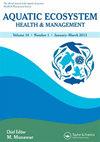32年中加关系的成就和教训。努力恢复大湖区受损的有益用途
IF 0.8
4区 环境科学与生态学
Q4 ENVIRONMENTAL SCIENCES
引用次数: 21
摘要
自1985年以来,各国政府和利益攸关方一直在制定和实施补救行动计划,以恢复被称为“关注区”的五大湖污染区的有益使用损害。最初,由于问题的严重性和地理范围、生态系统方法的使用缺乏明确性、利益相关者有效参与的时间承诺、管理计划的演变以及确保恢复资金的必要性,进展缓慢。随着时间的推移,其中许多制约因素已经得到克服。目前,截至2017年,七个关注领域已被除名,两个被指定为恢复关注领域,18个已实施了恢复使用所需的所有补救措施。尽管已经取得了进展,但要恢复所有受损用途并将所有关注领域除名,还有很多工作要做。值得注意的成就包括:使用生态系统方法和必要的治理框架、污染沉积物修复、栖息地恢复和富营养化控制。总结经验教训有助于完成关注地区的清理工作,并帮助其他地区恢复世界各地退化的水生生态系统。本文章由计算机程序翻译,如有差异,请以英文原文为准。
Achievements and lessons learned from the 32-year old Canada-U.S. effort to restore Impaired Beneficial Uses in Great Lakes Areas of Concern
Since 1985, governments and stakeholders have been developing and implementing remedial action plans to restore beneficial use impairments in polluted areas of the Great Lakes called Areas of Concern. Initially, progress was slow because of severity and geographic extent of the problems, lack of clarity on use of an ecosystem approach, time commitments for effective involvement of stakeholders, evolution of management programs, and need to secure restoration funding. Over time, many of these constraints have been overcome. Presently, as of 2017, seven Areas of Concern have been delisted, two have been designated as Areas of Concern in Recovery, and 18 have implemented all remedial actions deemed necessary for use restoration. Although progress has been made, much remains to be done to restore all impaired uses and delist all Areas of Concern. Notable achievements include: use of an ecosystem approach and requisite governance frameworks, contaminated sediment remediation, habitat rehabilitation, and control of eutrophication. Lessons learned are presented to help complete the cleanup of Areas of concern and help others restore degraded aquatic ecosystems worldwide.
求助全文
通过发布文献求助,成功后即可免费获取论文全文。
去求助
来源期刊

Aquatic Ecosystem Health & Management
环境科学-海洋与淡水生物学
CiteScore
1.70
自引率
0.00%
发文量
1
审稿时长
18-36 weeks
期刊介绍:
The journal publishes articles on the following themes and topics:
• Original articles focusing on ecosystem-based sciences, ecosystem health and management of marine and aquatic ecosystems
• Reviews, invited perspectives and keynote contributions from conferences
• Special issues on important emerging topics, themes, and ecosystems (climate change, invasive species, HABs, risk assessment, models)
 求助内容:
求助内容: 应助结果提醒方式:
应助结果提醒方式:


